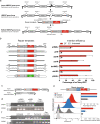Universal toxin-based selection for precise genome engineering in human cells
- PMID: 33479216
- PMCID: PMC7820243
- DOI: 10.1038/s41467-020-20810-z
Universal toxin-based selection for precise genome engineering in human cells
Erratum in
-
Author Correction: Universal toxin-based selection for precise genome engineering in human cells.Nat Commun. 2021 May 10;12(1):2832. doi: 10.1038/s41467-021-23345-z. Nat Commun. 2021. PMID: 33972550 Free PMC article. No abstract available.
Abstract
Prokaryotic restriction enzymes, recombinases and Cas proteins are powerful DNA engineering and genome editing tools. However, in many primary cell types, the efficiency of genome editing remains low, impeding the development of gene- and cell-based therapeutic applications. A safe strategy for robust and efficient enrichment of precisely genetically engineered cells is urgently required. Here, we screen for mutations in the receptor for Diphtheria Toxin (DT) which protect human cells from DT. Selection for cells with an edited DT receptor variant enriches for simultaneously introduced, precisely targeted gene modifications at a second independent locus, such as nucleotide substitutions and DNA insertions. Our method enables the rapid generation of a homogenous cell population with bi-allelic integration of a DNA cassette at the selection locus, without clonal isolation. Toxin-based selection works in both cancer-transformed and non-transformed cells, including human induced pluripotent stem cells and human primary T-lymphocytes, as well as it is applicable also in vivo, in mice with humanized liver. This work represents a flexible, precise, and efficient selection strategy to engineer cells using CRISPR-Cas and base editing systems.
Conflict of interest statement
S.L., N.A., S.C., M.P,. S.W., A.L., C.M., M.F., E.G., B.L., A.S., L.S.P., M.A.C., G.P., M.S., M.B.-Y., B.J.T., G.S., and M.M. are employees and shareholders of AstraZeneca. M.M. and S.L. are listed as co-inventors in a Astrazeneca patent application (application number: EP2020060250W) related to this work. The other authors claim no competing interests.
Figures







Similar articles
-
Optimized prime editing of the Alzheimer's disease-associated APOE4 mutation.Stem Cell Reports. 2025 Jan 14;20(1):102372. doi: 10.1016/j.stemcr.2024.11.002. Epub 2024 Dec 5. Stem Cell Reports. 2025. PMID: 39642875 Free PMC article.
-
Efficient Genome Editing in Induced Pluripotent Stem Cells with Engineered Nucleases In Vitro.Methods Mol Biol. 2017;1521:55-68. doi: 10.1007/978-1-4939-6588-5_4. Methods Mol Biol. 2017. PMID: 27910041
-
Development of a CRISPR/Cas9 genome editing toolbox for Corynebacterium glutamicum.Microb Cell Fact. 2017 Nov 16;16(1):205. doi: 10.1186/s12934-017-0815-5. Microb Cell Fact. 2017. PMID: 29145843 Free PMC article.
-
Genome engineering tools for building cellular models of disease.FEBS J. 2016 Sep;283(17):3222-31. doi: 10.1111/febs.13763. Epub 2016 Jun 22. FEBS J. 2016. PMID: 27218233 Free PMC article. Review.
-
Precision genome engineering through adenine and cytosine base editing.Nat Plants. 2018 Mar;4(3):148-151. doi: 10.1038/s41477-018-0115-z. Epub 2018 Feb 26. Nat Plants. 2018. PMID: 29483683 Review.
Cited by
-
Marker-free co-selection for successive rounds of prime editing in human cells.Nat Commun. 2022 Oct 7;13(1):5909. doi: 10.1038/s41467-022-33669-z. Nat Commun. 2022. PMID: 36207338 Free PMC article.
-
Disease modeling by efficient genome editing using a near PAM-less base editor in vivo.Nat Commun. 2022 Jun 15;13(1):3435. doi: 10.1038/s41467-022-31172-z. Nat Commun. 2022. PMID: 35701478 Free PMC article.
-
High-throughput screening of human genetic variants by pooled prime editing.Cell Genom. 2025 Apr 9;5(4):100814. doi: 10.1016/j.xgen.2025.100814. Epub 2025 Mar 21. Cell Genom. 2025. PMID: 40120586 Free PMC article.
-
Optimized prime editing of the Alzheimer's disease-associated APOE4 mutation.Stem Cell Reports. 2025 Jan 14;20(1):102372. doi: 10.1016/j.stemcr.2024.11.002. Epub 2024 Dec 5. Stem Cell Reports. 2025. PMID: 39642875 Free PMC article.
-
Enrichment strategies to enhance genome editing.J Biomed Sci. 2023 Jul 1;30(1):51. doi: 10.1186/s12929-023-00943-1. J Biomed Sci. 2023. PMID: 37393268 Free PMC article. Review.
References
-
- Dunbar CE, et al. Gene therapy comes of age. Science. 2018;359:eaan4672. - PubMed
-
- June CH, O’Connor RS, Kawalekar OU, Ghassemi S, Milone MC. CAR T cell immunotherapy for human cancer. Science. 2018;359:1361–1365. - PubMed
-
- Labanieh L, Majzner RG, Mackall CL. Programming CAR-T cells to kill cancer. Nat. Biomed. Eng. 2018;2:377–391. - PubMed
-
- Xin Yu,J, Hubbard-Lucey VM, Tang J. The global pipeline of cell therapies for cancer. Nat. Rev. Drug Discov. 2019;18:821–822. - PubMed
Publication types
MeSH terms
Substances
LinkOut - more resources
Full Text Sources
Other Literature Sources
Medical

